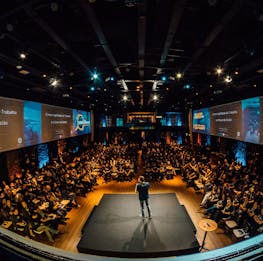Perhaps, judging a book by its cover isn't such a bad thing after all.
Blink offers insight into what happens during the fleeting moments, that it takes us to make a snap judgment. Using a series of stories, and a broad range of case studies, Malcolm Gladwell gives us examples that illustrate how making quick, intuitive snap judgments can be beneficial.
Briefly, the purpose of Blink is threefold. Firstly, it explores the first few seconds that it takes to come to a decision. Secondly, it provides advice and examples of when to use unconscious, over conscious thinking. Finally, it shows us that it's possible to make controlled and educated snap decisions.
The First Two Seconds
How often have you heard the phrases, "Trust your instincts," or "When you know, you know?"
If a speeding car is hurtling towards you, how do you think you'd react? It's unlikely that you'd weigh up your options and compose a pros-and-cons list. Most of us would rely on intuition.
The first few seconds of decision making, particularly regarding snap judgments, are pivotal. At what point should we abandon conscious strategy, which is the slow and logical process of gathering information, and opt for intuition instead? This book deals mostly with the latter.
Our environment is a crucial component of the human experience. A lot of our knowledge has developed in relation to our surroundings. This process, known as the adaptive unconscious, means that we have evolved alongside our environment. We navigate the world around us based on what we've learned. Hence, when we're confronted with precarious or unique situations, we can make quick decisions based on our experiences.
Decision making is something that we're continuously learning, particularly regarding how to adapt to a constantly changing environment. We subconsciously capture data in everyday life, and use this to make decisions about the world around us. We need to trust this process of adaptive unconscious decision making, because it helps us develop intuition.
Thin-slicing is a critical process in intuition, and quick decision making. In a nutshell, thin-slicing means that we can filter out all of the relevant information, to make relatively quick decisions.
One of the benefits of thin-slicing, is that we don't need a lot of information to make quick decisions. Instead, we can rely on individual experience and context. For example, when we go to someone's house for the first time, we can often tell a lot about the personalities of those who live there. We take a thin-slice of the residents' experience and environment and draw on generalizations. This process is predominantly unconscious, and it allows us to make a judgment based on a relatively small amount of visual information.
Thin-slicing is an effective decision-making method, because it's a way of sifting through a lot of information to focus on what's most important. And, as It turns out, the unconscious is really good at doing this. The benefit of this is that it frees up the conscious mind to focus on other things.
The disadvantage of thin-slicing is that our subjectivity often clouds it. Bias, prejudice, and stereotyping can affect how we make decisions. Additionally, we humans can be primed to behaving in specific ways.
When Should We Use Unconscious Thinking, As Opposed to Conscious Thinking?
At some point, we've all heard that we should, "Sleep on it," or "Think it over."
The subtext of phrases like these is that; quick decisions are bad. And, conversely, methodically considered decisions are good. The idea is that decision quality is directly proportionate to the time we spent making them.
We have an innate bias towards quick decision making. We've become suspicious of making decisions too quickly. From an early age, we're taught to consider all of our options and weigh things up carefully. We're taught that the best decisions are the ones that we mull over, and take our time to consider.
Living in the information age can be daunting. It can be comforting to know, that we don't always need a lot of information to make a good decision. Some of the best decisions that we make, we can make quickly. And, although we're inherently wary of quick or intuitive decisions, these are sometimes the best ones.
Thin-slicing is a quick and effective method of gathering information, by relying on patterns, based on both knowledge and experience. It avoids being distracted by information overload, and encourages us to filter out critical slices of information. This method of decision making is a quick and effective way of reaching a decision. However, it's important to be aware of our own subjectivity and bias when making snap decisions.
There are times that we rely on our intuition when making decisions. In these circumstances, we often don't actually know the reason why we've drawn certain conclusions.
How often have you reached a conclusion through trusting your intuition, without knowing how you arrived at the answer? Gut feelings and instinct are questions that have baffled many researchers.
Whereas thin-slicing has a logic to it, gut feelings do not. Gut feelings are mysterious and often hidden behind a metaphorical locked door.
The author's suggestion for dealing with gut feelings, is that we respect the mystery. Respect what's unknown, behind the locked door. And, realize that sometimes it's okay to know something, without knowing how and why we know it.
Snap Judgments Can Be Educated and Controlled
When was the last time you were told not to be so impulsive?
So often, we're told not to be impulsive and to, "consider the options." Gladwell argues that there are ways to control snap judgments. To make better intuitive decisions. The way to do this is to develop one's intuition using a combination of experience, training, and knowledge.
Decide what information is essential regarding snap judgments. This process is an exercise in selection, while being frugal with information. Sometimes, too much information isn't a good thing.
Realize that not everything can be controlled or understood. Gut feelings are an important part of our intuition, and it's okay if you can't rationalize them.
Understand that bias and subjectivity will cloud your judgment, and influence your decisions. Seek out new experiences to broaden your knowledge about alternate views and opinions.
Practice making a series of snap judgments, and ask yourself how you'd behave in specific scenarios. We improve by interacting with others and experiencing changing environments. Hence, training yourself to make better decisions is possible, and it's an ongoing process. As the adage goes, "practice makes perfect."
Learn to predict and acknowledge your subjectivity. Embrace diversity and difference. Realize that you can learn from people and places that aren't what you're used to.
Finally, be observant and engage with people. Make sure you listen more. Pay attention to how people behave in different environments and different contexts. Acknowledge that the context is a critical factor in how you make conscious, and unconscious decisions.
In Conclusion
Blink is concerned with helping us to make better decisions in everyday life. The popular science book makes the process of conscious and unconscious decisions more accessible, by utilizing a diverse range of case studies. Drawing on psychology, sociology, and behavioral economics, Gladwell offers insight into how we reach snap judgments, when to use snap judgments, and how to improve our own decision making.
By challenging the myths around intuition, Gladwell shows us that the best decisions are often the ones we make quickly. Ultimately there's merit in taking things at face value.




